biology
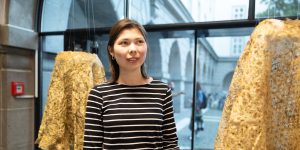
Rhizomes
Freya Probst (DE/UK)
These grown gowns are the outcome of a series of experiments and playful interactions with plants and the observation of their roots through photography or time-lapse video. Experiments with pearls, small gears, or the positioning of seeds lead to different plant responses. The outcome was eventually applied to larger surface areas in the shape of cutting patterns reminiscent of fine woven textiles. The exhibits show a subterranean, hidden aesthetic of a natural structure that cannot be copied by humans.
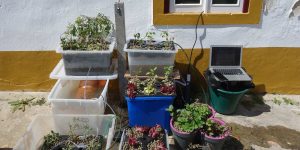
Expert Tour: Biomedia Art: Microbioms, Plantamorphisations and Trans-species relationships
Jens Hauser (DE/FR/DK)
This expert tour guided by curator, media theoretician, and Ars Electronica Jury member Jens Hauser will provide insights into the underlying philosophical and techno-scientific aspects of selected biology-based artworks in the POSTCITY exhibition.
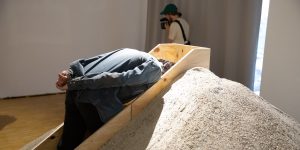
Drosophila Karaoke Bar
Ursula Damm (DE)
Drosophila Karaoke Bar invites visitors to establish a direct exchange with fruit flies through a technical interface that invites visitors to talk and sing with the flies.

Humus, Humanity & Humility
Julian Chollet (DE)
Humus is more important than art, money, or success. Humanity depends on intact ecosystems and fertile soil. Humility and responsibility will help our species survive.
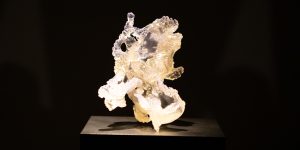
The Eye of the Other
MAEID – Daniela Mitterberger (AT), Tiziano Derme (IT/AT)
The Eye of the Other delves into non-verbal communication between humans and bats, through the study, translation and manipulation of the bat’s echolocation. This multimodal immersive artwork derives from the desire to transcend the limitation of our living experience by exploring the deeper meaning of mutualistic relationships and interspecies communication between humans and animals, juxtaposing the animals’ gaze and the human gaze.
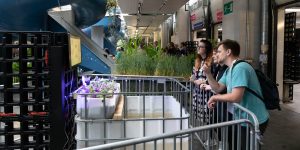
TeleAgriCulture_Rhizomatic Bias
Julian Stadon (AU), Erik Overmeire (NL), Daniel Artamendi (ES), V2_ Lab for Unstable Media (NL)
What happens if biotopes start chatting to each other using social network communication models? TeleAgriCulture_Rhizomatic Bias aims to explore how bias grows in machine learning and intelligent systems. This artistic provocation points at the much larger problems we face when our emotional biases and social constructions affect the way artificial intelligent systems evolve and impact our lives.
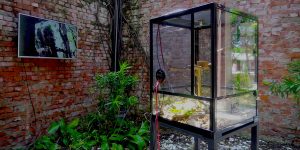
Shared Habitats
The exhibition Shared Habitats focuses on the influence of technology on socio-cultural processes through fourteen works of a digital, biological, and interactive nature. The exhibition focuses on the location of organisms in their environment, the effects of humans on their habitats, and the artistic handling of new biomaterials and technologies. Many of the works on display are based on scientific experiments that are analyzed in a cultural context.
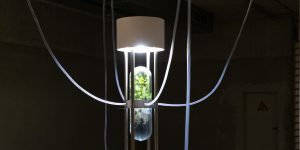
Earthlink
Saša Spačal (SI)
Earthlink performs a planetary biogeochemical feedback loop catalyzed by microbial metabolism. Through the intimate process of breathing, humans are bound to the planet, immersed in an intra-flux of exchanges and negotiating relationships. What happens when the connections become technologically mediated? How will we breathe? Who or what will dispense the dose? Who will survive? How will we grieve?

Species Reclamation Via a Non-linear Genetic Timeline: An Attempted Hymenochirus curtipes Model Induced by Controlled Breeding
Brandon Ballengèe (US)
This project involved the selective breeding of frogs from the Hymenochirus family, located in the Congo. There, biodiversity is threatened by forest clearing and increased demand for wood. Also, political turmoil in Congo has limited biological studies and conservation efforts. In their native habitat, wild Hymenochirus populations may currently be in decline or have become extinct.
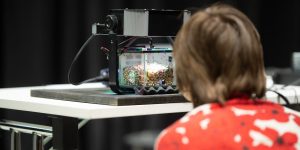
^lgorithmZoo Pt. 5. : KTV Session
Rico Graupner (DE)
^lgorithm Zoo pt. 5 "KtV Sessions Vol II. is a concert series that deals with the sonic fusion of different biological habitats. In this case, a beetle-controlled synthesizer interacts with the sound installation ZoomBx. The movement events of the insects are tracked by a specially developed software (IcCE) that makes it possible to map the acquired data to musical parameters as well as different positions in space.


